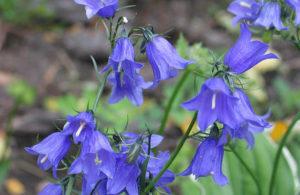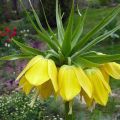Growing and caring for eustoma in the open field, breeding methods and varieties
Eustoma is a beautiful flower from the Gentian family. The second name of the plant is lisianthus, and among the people several more names have been invented for it, namely "Irish rose", "Japanese rose" and "Texas bell". Growing an eustoma will take some effort, but it will be worth it.
Content
- 1 Characteristics and description of the culture
- 2 In which regions is it recommended to plant a plant
- 3 Types of perennial eustoma
- 4 Necessary conditions for growing
- 5 How to plant eustoma in the garden
- 6 Seedling care after sowing
- 7 How to properly care for a flower
- 8 How to protect against parasites and pests
- 9 Flower reproduction methods
- 10 What problems do novice gardeners most often face?
Characteristics and description of the culture
Eustoma has a high decorative effect, therefore it is popular among gardeners and florists. The plant has strong but graceful stems. From the middle of the stem, it begins to branch, so one branch looks like a full-fledged bouquet, which can number up to 30 inflorescences. Lisianthus leaves with a bluish or grayish tint, matte.
Inflorescences come in various shapes with a diameter of about 5-8 cm. The color is different: pink, lilac, purple, blue, yellow and white. There are examples of one-color, two-color and with a contrasting border. The inflorescences are double or simple. In the half-open position, the flower looks like a simple rose, and when fully opened, it resembles a double poppy.
The flowering period occurs in the second half of July and lasts until October.
In which regions is it recommended to plant a plant
In areas with excessive moisture, eustoma does not take root well. The southern regions are the most favorable for flower cultivation. But in Siberia and the Urals, this flower is cultivated only in greenhouses and in indoor conditions.
Types of perennial eustoma
Eustoma is becoming quite popular and is increasingly found in gardening stores. These flowers are divided into two types.
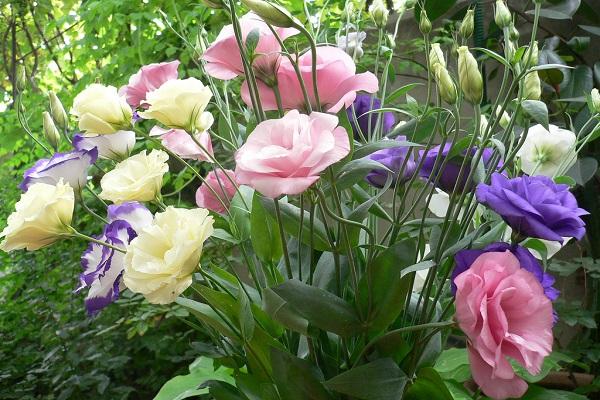
Tall varieties
Tall representatives of Lisianthus grow from 50 cm to 1 m.They are most often grown in the country for a cut. They have a large number of inflorescences on one stem, which look perfect in bouquets and do not fade for a long time.
Several varieties of tall eustomas:
- Echo Pink Pikoti. This is an early variety. The height of the stems reaches 70 cm. The inflorescences are rather large, double, with a white color and a pink frame.
- Flamenco.This variety starts flowering 2 weeks earlier than other members of the species. Inflorescences can be pale blue, pale yellow, pale pink, milky or almost white. Height 70 cm.
- Mariachi lime. The growth of this variety reaches 1 m. The flowers are super-double, 7 cm in diameter. The flowers resemble roses, they have a light green color.

Low growth varieties:
- Fidelity. The flower has many simple inflorescences with white petals, which are arranged in a spiral. The height of the Vernost variety is 20 cm.
- Mermaid. The variety has funnel-shaped flowers of lilac, pink or white. The leaves are gray with a waxy coating. Height about 15 cm.
- Riddle. The flower has semi-double inflorescences with pale blue petals. Abundant flowering. Height - up to 20 cm.
Undersized or indoor
Low-growing species of these flowers grow no higher than 30 cm. They are often planted in pots and grown on windowsills in winter and on balconies in summer. Indoor eustoma bushes are compact and highly decorative.
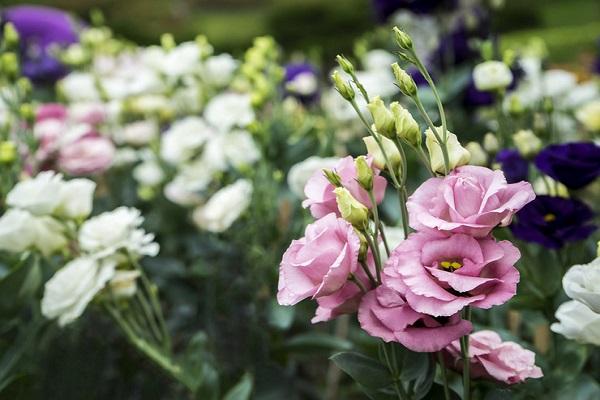
Necessary conditions for growing
In order to grow this rather whimsical flower, you need to know in what conditions it should be done.
Illumination and humidity
For the first 2 months, plants need bright, diffused light. For this, lamps with daylight are used, since natural light is not enough. This is necessary so that the sprouts do not stretch.
Temperature regime
The most favorable temperature for eustoma in the daytime is + 20-25 degrees, and at night +15 degrees. In winter, if possible, the plants are brought into the premises and provide a temperature regime within + 10-12 degrees.
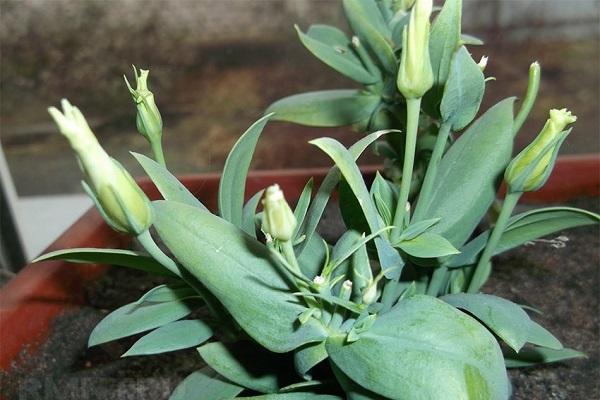
Required soil composition
The soil in which the plant will develop must have a low acidity, not higher than 6.5-7.0, and be breathable. Ash, peat and sand are added to deoxidize and improve the soil. If the soil is correct, then Lisianthus can be grown as a perennial plant.
Used for sowing seeds and purchased substrate. Suitable soil for Saintpaulias.
How to plant eustoma in the garden
Planting a flower through seeds is the most common and simple.
Presowing seed treatment
Lisianthus seeds are very small, like dust. In this regard, the factories where the seeds are packaged are treated with special substances. They form granules around the seeds. This not only makes sowing more convenient, but also helps the seeds germinate, because the granule consists of fertilizers and growth stimulants.

Choosing the right place
The flower should be planted in a place protected from wind and draft. In the selected area, the plant should not be under the scorching rays of the sun all day. It is better if the eustoma grows in a diffused shade.
Timing and technology of sowing seeds
When choosing the time of sowing the seed, you need to take into account that the flowering period of Lisianthus begins 15-20 weeks after the germination of the first shoots. Therefore, sowing begins in winter.
In order to sow seeds, you need to prepare a container, fill it with moist soil. To do this, mix peat and sand in equal proportions. Seeds are scattered over the soil, burying them a little into the ground. Cover the container from above with a film or a sheet of glass. They are sent to a warm place where the air temperature will not be lower than +19 degrees.
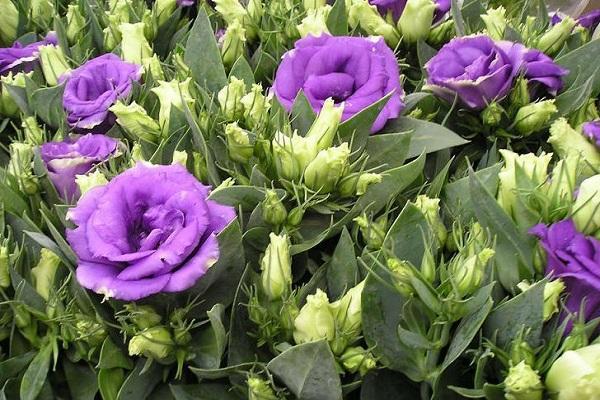
Seedling care after sowing
The container with crops should be in a bright place. If necessary, spray the soil with water. After 2-3 weeks, the first shoots will appear. After the first 2 leaves are formed in the sprouts, the number of waterings is reduced. The soil should have time to dry out between irrigations. Further watering is carried out only in the morning. After the flower has 4 leaves, they can be dived.
Important! Over-watering can cause black leg disease.
Picking
Seedlings dive into separate containers with a diameter of about 5 cm.This is done carefully so as not to damage the delicate and fragile sprouts. They carefully pry the earth with something thin and transfer the plant into a glass with a small lump. Cover the remaining place with fertile soil and water the seedlings. And after 30 days, the grown plants are planted in open ground.
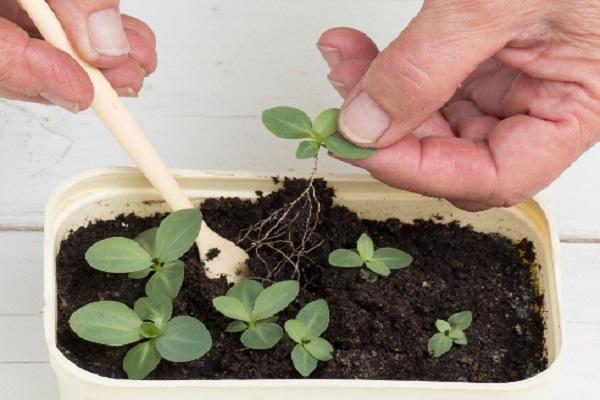
Planting seedlings in open ground
Saplings are planted in flower beds towards the end of May. At this point, she should have 4 to 8 sheets. Once the flower is planted in the soil, it quickly begins to grow.
When planting lisianthuses, gardeners adhere to the following recommendations:
- the appropriate time of day for disembarkation is evening;
- when transplanting seedlings, they should be removed from the pot along with the earth and moved into the hole, filling with fertile soil;
- when planting eustoma in the soil, you cannot bury it deeper than it grew in a pot;
- immediately after transplanting, each sprout is covered with a jar or tall glass to protect it from a strong temperature jump.
How to properly care for a flower
In order to organize proper care for eustoma, you need to know the rules for watering, feeding, transplanting and combating diseases.
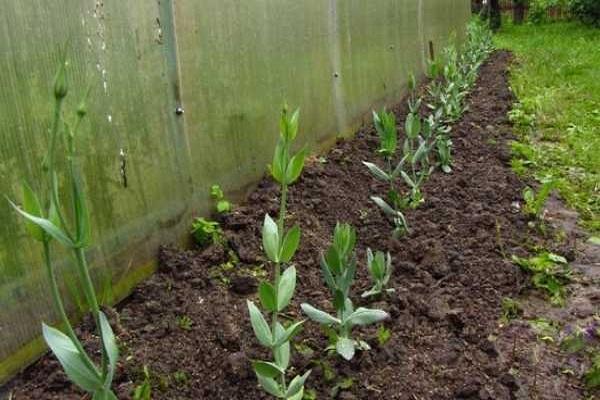
Watering and loosening
Watering is done with warm, standing water. The soil should be slightly dry before watering. Periodically loosening the soil is carried out to destroy weeds and better penetration of oxygen into the soil.
Top dressing
And they begin to feed the eustomas from the 10-14th day after planting in the ground. During vigorous growth, feeding is carried out once every 2 weeks. They are also necessary during the budding period and during the flowering itself.
All fertilizers that dissolve in water are used for feeding.
Garter
Tall specimens need a garter. The stem of the plant may not support the weight of the numerous inflorescences and break or bend over. At the first sign of lodging, a garter should be made. To do this, pegs are driven into the ground and, tying a rope to them, they twine a bush with it. Instead of a garter, decorative supports are also used.
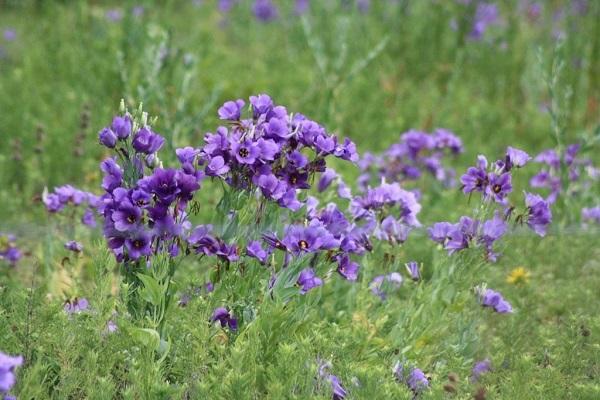
Transfer
The flower is rarely transplanted, as it has a very vulnerable root system. If, nevertheless, a transplant is necessary, then the plant is transferred to a new place with a large clod of earth in order to injure the roots of the flower as little as possible.
Disease prevention
For the prophylactic treatment of diseases, even at the stage of the first shoots, plants are sprayed with a solution of "Fundazol" or "Ridomil". Further, throughout the entire development cycle, the flower will need to be treated with these preparations. For 1 liter of water, 1 tsp is required. facilities.
Most often, the flower is affected by such diseases:
- blackleg;
- powdery mildew;
- gray rot;
- fusarium wilting.
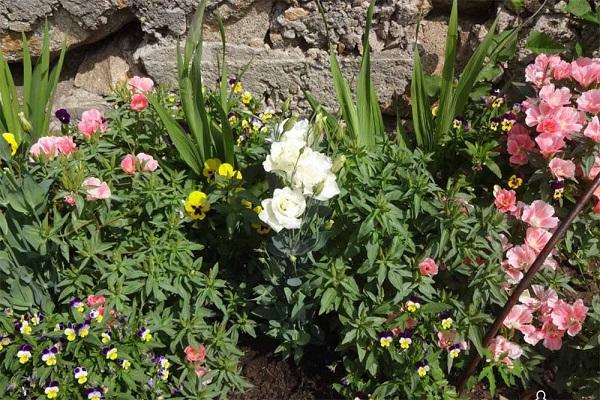
How to protect against parasites and pests
Lisianthuses belong to the Gentian family, so they have a bitter juice, and usually most pests bypass them. But if they nevertheless attacked the plants, they are destroyed with the help of insecticides, "Confidor", "Actellik" or "Fitoverm" will do.
The plant can be damaged by such pests:
- aphid;
- mealy mite;
- greenhouse whitefly;
- slugs.

Shelter plants for the winter
It is best to move the eustoma into the house for the winter, transferring it to a large flowerpot. But if this cannot be done, then the plants are covered. The flower can endure such wintering only in the southern regions, where winters are not so severe. For this reason, eustoma is often grown as an annual plant.
Flower reproduction methods
In order to propagate a plant, you need to know the possible options for this process.
Seeds
To propagate a plant using seed, you must first collect them. The collection is carried out only from varietal specimens. It makes no sense to collect seeds from hybrids, because the seedlings will not transfer the qualities of the mother bush.
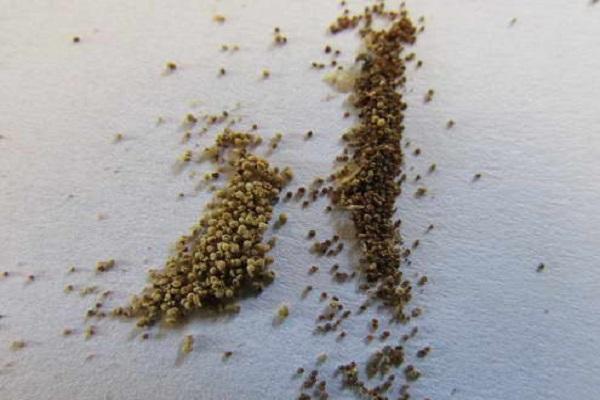
The collection is carried out carefully, because the seeds are very small, and only after the seed box is completely dry. The collected material is sown for seedlings.Sowing is carried out in winter.
Rhizome
These flowers do not propagate by dividing the roots. They have a very sensitive root system. If the root is damaged, the plant will die.
Cuttings
It will also not be possible to propagate eustoma by cuttings, since the cuttings do not take root in the soil.
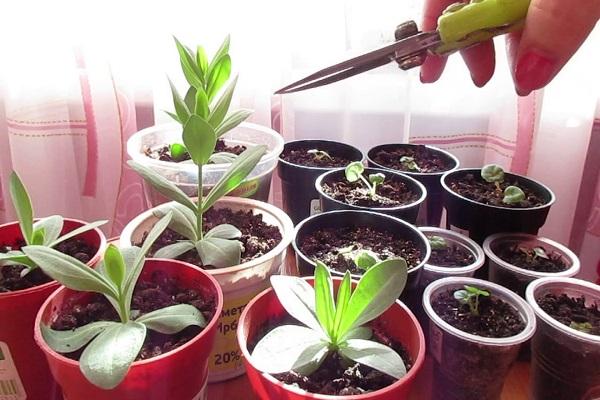
What problems do novice gardeners most often face?
Novice gardeners should know some of the nuances in growing these capricious but beautiful flowers:
- When watering, you need to know that eustoma is sensitive to overflow. If the soil is poorly drained and moisture stagnates under the bush, there is a great chance of flower death.
- Do not plant Lisianthus bushes near metal or brick fences and walls. In hot weather, this can cause burns to the delicate plant. Metal and brick get very hot in the sun and touching the plant can damage it.
- Flowers are not planted in drafts. In such places, they wither and die.
- Often, eustoma seeds do not germinate well, so only fresh material should be selected for sowing.
- Do not move potted Lisianthus from one place to another often. They react poorly to sudden changes in temperature.
- When sowing seeds for seedlings in winter, it is better to light up the seedlings. The required period for receiving light is 12-14 hours a day.
- The seedlings should not only be watered periodically, but ventilated. Gardeners do this once a day.
When growing eustoma, you need to adhere to all the rules of planting and caring for the plant. What may seem insignificant to a gardener can be fatal for a plant.
